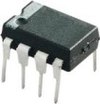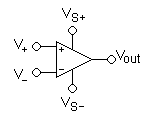Electronics/Op-Amps
Electronics | Foreword | Basic Electronics | Complex Electronics | Electricity | Machines | History of Electronics | Appendix | edit
Op-Amp (operational amplifier)
[edit | edit source]Op-amp stands for operational amplifier. It is available in IC (Integrated Circuit) chip. It is an electronic circuit of many electronic components already connected and packaged inside a chip of many pins for external connection. Originally, op-amps were so named because they were used to model the basic mathematical operations of addition, subtraction, integration, differentiation, etc. in electronic analog computers. In this sense a true operational amplifier is an ideal circuit element.
741 Op-amp
[edit | edit source]Symbol
[edit | edit source]The 741 op-amp has a symbol as shown.
Its terminals are:
- V+: noninverting input
- V−: inverting input
- Vout: output
- VS+: positive power supply
- VS−: negative power supply
Operation
[edit | edit source]The 741 op-amp can be thought as Universal Voltage Difference Amplifier. The main function of the 741 op-amp is to amplify the difference of two input voltages which can be expressed mathematically like below
From
- . The op-amp acts as a voltage difference amplifier.
It can be shown that an op-amp can function as a noninverting voltage amplifier or inverting voltage amplifier.
- . . The op-amp acts as a noninverting voltage amplifier.
- . . The op-amp acts as an inverting voltage amplifier.
Also, it can be shown that an op-amp can function as a voltage comparator
- . . No difference between the two input voltages
- Vo = VS+ . . Non Inverting input voltage is greater than the Inverting input voltage
- Vo = VS- . . Inverting input voltage is greater than the Non Inverting input voltage.
Ideal Op-amps
[edit | edit source]The output voltage is the difference between the + and - inputs multiplied by the open-loop gain
- Vout = (V+ − V−) * Avo.
The ideal op-amp has
- an infinite open-loop gain,
- infinite input impedances and
- zero output impedance.
- The input impedance is the impedance seen between the noninverting and inverting inputs.
The model for the op-amp is shown in Figure 1. Where V+ − V− is equal to vd; Rin is the input impedance; Rout is the output impedance; Avo is the open loop gain; and Rs is the source impedance.
- Figure 1: The model of the op-amp.
Using voltage divider rule, we can determine the voltage vd.
- (1)
Since the dependent voltage source amplifies the voltage vd by Avo. We can work out the output voltage across RL once again using voltage divider rule.
- (2)
Substituting equation 1 into 2.
Now if the properties of an Ideal op-amp are applied. The ideal properties of an op-amp are infinite input impedance and zero output impedance. Since Rin >>, much greater than, Rs, Rin/(Rin+Rs) 1.
Which is basically the definition of an op-amp. But if the input impedance was not infinite and the output impedance nonzero then this would not be so.
Real Op-amps
[edit | edit source]Real op-amps are (normally) built as an integrated circuit, but occasionally with discrete transistors or vacuum tubes. A Real op-amp is an approximation of an Ideal op-amp. A real op-amp does not have infinite open loop gain, infinite input impedance nor zero output impedance. Real op-amps also create noise in the circuit, have an offset voltage, thermal drift and finite bandwidth.
An offset voltage
- means that there exists a voltage vd when both inputs are grounded. This offset is called an input offset because the voltage vd is offset from its ideal value of zero volts. The input offset voltage is multiplied by the open loop gain to create an output offset voltage.
Thermal drift
- means that the characteristics of the op-amp change with temperature. That is the open loop gain, input and output impedances, offset voltages and bandwidth change as the temperature changes.
Finite bandwidth
- Op-amps are made up of transistors. Transistors can only respond at a certain rate because of certain capacitances that they have. This means that the op-amps cannot respond fast enough to frequencies above a certain level. This level is the bandwidth.
Modern integrated circuit MOSFET op-amps approximate closer and closer to these ideals in limited-bandwidth, large-signal applications at room temperature. When the approximation is reasonably close, we go ahead and call the practical device an 'op-amp', forget its limitations and use the thinking and formulae given in this article.
DC Behaviour
[edit | edit source]Open-loop gain is defined as the amplification from input to output without any feedback applied. For most practical calculations, the open-loop gain is assumed to be infinite; in reality, however, it is limited by the amount of voltage applied to power the operational amplifier, i.e. Vs+ and Vs- in the above diagram. Typical devices exhibit open loop DC gain ranging from 100,000 to over 1 million. This allows the gain in the application to be set simply and exactly by using negative feedback. Of course theory and practice differ, since op-amps have limits that the designer must keep in mind and sometimes work around.
AC Behaviour
[edit | edit source]The op-amp gain calculated at DC does not apply at higher frequencies. This effect is due to limitations within the op-amp itself, such as its finite bandwidth, and to the AC characteristics of the circuit in which it is placed. The best known stumbling-block in designing with op-amps is the tendency for the device to resonate at high frequencies, where negative feedback changes to positive feedback due to parasitic lowpasses.
Typical low cost, general purpose op-amps exhibit a gain bandwidth product of a few MHz. Specialty and high speed op-amps can achieve gain bandwidth products of 100s of MHz.
Op-amp Configurations
[edit | edit source]Applications
[edit | edit source]- audio and video pre-amplifiers and buffers
- voltage comparators
- differential amplifiers
- differentiators and integrators
- Filters
- Precision rectifiers
- Precision Peak Detector
- voltage and current regulators
- analogue calculators
- Voltage clamp
- analogue-to-digital converters
- digital-to-analogue converters
Quick Design Process
[edit | edit source]Imagine we have a (weak) input signal, and we want to amplify it to generate a strong output signal; or we have several different voltages, and we want to add them together. For these purposes, we need op-amp amplifying and summing circuits. It seems that there is nothing new to say about these bare (usually single op-amp) circuits. Only, the innovator Dieter Knollman has suggested a new simpler design procedure in an EDN's article [1]. He has also placed his work on the web[2] (see also a circuit story[3] written after Dieter's work).
We assume:
- All inputs are ideal voltage sources.
- Gain is defined as the gain from the ideal voltage source to the op-amp output.
- The feedback resistor, Rf, connects from the op-amp output to the inverting input.
- The input resistor, Ri, connects from the ideal voltage source input to the op-amp input. (This *includes* any source resistance).
- positive-gain inputs connect (through that resistor) to V+
- negative-gain inputs connect (through that resistor) to V−
Design procedure:
- First, specify the desired circuit gains for each input.
- Then calculate the ground gain, as follows:
- Daisy's theorem:
- The sum of the gains = +1 in a properly-designed op-amp circuit.
Therefore, choose
- Ground gain = 1 - ( the sum of the desired positive and negative gains).
- Choose a feedback-resistor value. For example, let Rf=100 kiloOhms.
- Next, calculate the resistor values for each input, including the ground-gain resistor, using
- .
- where |gain| is the absolute value of the desired gain.
Some op-amp circuits need a resistor to ground from the op-amp's inverting input.
Others need a resistor to ground on the noninverting input.
The sign of the ground gain determines where to place the ground resistor.
If the desired gains add up to one, a resistor to ground is unnecessary.
You will see below some examples that illustrate using the quick design procedure. First of all, answer the question, "What's the highest and lowest output voltage you want?" Make sure the power terminals of the op-amp are at least that high and low. (If you want it to swing from +5 V to -5 V, then an op-amp connected to 0 V and +10 V won't work).
The generic op-amp has two inputs and one output. (Some are made with floating, differential outputs.) The output voltage is a multiple of the difference between the two inputs:
floating outputs? Are you perhaps misunderstanding "fully differential amplifier" ?
- Vout = G(V+ − V−)
G is the open-loop gain of the op-amp. The inputs are assumed to have very high impedance; negligible current will flow into or out of the inputs. Op-amp outputs have very low source impedance.
If an Operational Amplifier is used with positive feedback it can act as an oscillator.
Other Notation
[edit | edit source]The power supply pins (VS+ and VS−) can be labeled many different ways. For FET based op-amps, the positive, common drain supply is labeled VDD and the negative, common source supply is labeled VSS. For BJT based op-amps, the VS+ pin becomes VCC and VS− becomes VEE. They are also sometimes labeled VCC+ and VCC−, or even V+ and V−, in which case the inputs would be labeled differently. The function remains the same.
Fully Differential Amplifier
[edit | edit source]Basic Applications
[edit | edit source]... insert drawings of basic FDA amplifying circuits here ...
Fully Differential Amplifier versus Instrumentation Amplifier
[edit | edit source]An instrumentation amplifier has extremely high input impedance-- much higher than the input impedance of a fully differential amplifier (once all the feedback resistors are in place). So an instrumentation amplifier is better for measuring voltage inputs with unknown (and possibly time-varying) output resistance.
A fully differential amplifier is better than an instrumentation amplifier for precisely generating differential output voltages, with good rejection of differential noise on the input, output, and power lines.
Applying a Quick Design Procedure
[edit | edit source]Can we apply Dieter's procedure to a fully differential amplifier? We can, if we revise it a little:
- Daisy's theorem revised:
- The sum of the gains = 0 in a properly-designed fully differential amplifier circuit.
Here is the FDA quick design procedure:
- Use equal feedback resistors Rf, one from the + output to the - input, and one from the - output to the + input. Connect the "common" input to the appropriate voltage source.
- The sum of the gains = zero in a properly-designed fully differential amplifier circuit (note that this new formulation differs from Daisy's theorem, which claims that the sum is always 1).
- Calculate resistor values for each input, using Ri = Rf / |desired gain|.
- For inputs with positive gain, connect the calculated resistor value between that input and the + input on the amplifier.
- For inputs with negative gain, connect the calculated resistor value between that input and the - input on the amplifier.
- If all your inputs are differential pairs, then the sum of all the gains is now zero. Done. Otherwise add a ground resistor to bring the total gain to zero.
Example 7 (a classic design procedure):
Example 8 (a quick design procedure):
References
[edit | edit source]- ↑ Single-formula technique keeps it simple - EDN's article by Dieter Knollman, PhD, Lucent Technologies
- ↑ K9 analysis make analog circuit design and analysis doggone simple
- ↑ How to Simplify the Design of the Mixed Op-amp Voltage Summer (after EDN's Single-formula technique keeps it simple)
See also
[edit | edit source]- Voltage compensation reveals the philosophy behind op-amp inverting circuits with negative feedback
Further reading
[edit | edit source]- Sergio Franco, "Design with Operational Amplifiers and Analog Integrated Circuits," 3rd Ed.], McGraw-Hill, New York, 2002 ISBN 0-07-232084-2
- Linear Databook published in 1982 by The National Semiconductor Corporation.



















